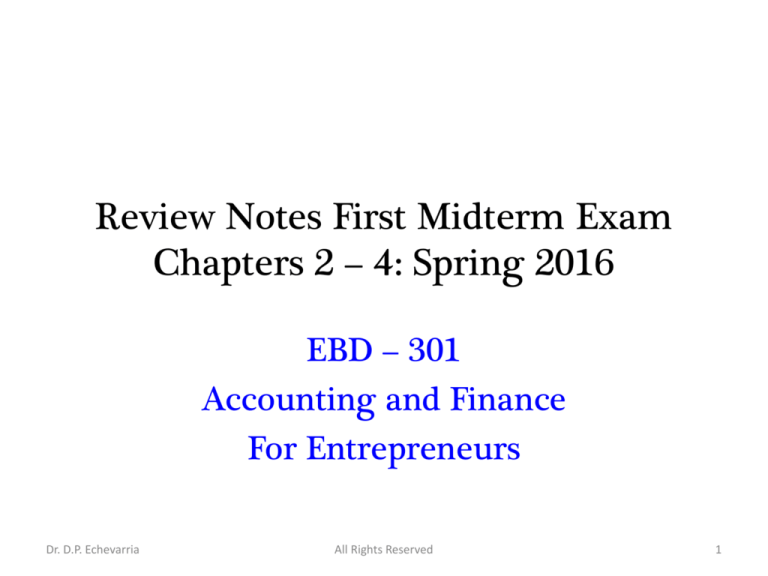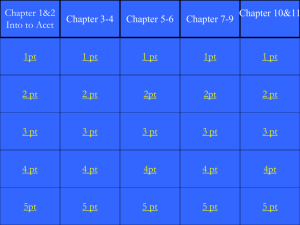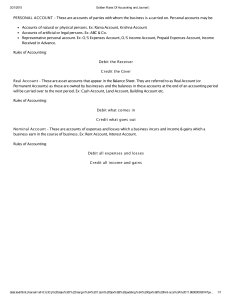
Review Notes First Midterm Exam
Chapters 2 – 4: Spring 2016
EBD – 301
Accounting and Finance
For Entrepreneurs
Dr. D.P. Echevarria
All Rights Reserved
1
Chapter 2
Basics of Record Keeping
• Timely and accurate financial records help
to;
– Monitor the progress of the business
– Prepare financial statements
– Identify sources of revenues and expenses
– Provide data for preparing tax returns
Dr. D.P. Echevarria
All Rights Reserved
2
Chapter 2
Basics of Record Keeping
• Two Areas of Focus
– Financial Accounting
• Systematic recording of all business transactions
• Prepare Financial Statement
– Balance Sheet
– Income Statement (P&L)
– Managerial Accounting
• Using accounting data to analyze the business
Dr. D.P. Echevarria
All Rights Reserved
3
Chapter 2
Basics of Record Keeping
• Two Basic Methods
– Single-Entry (best for cash only business)
– Double-Entry (Debits and Credits)
• Decision Criteria
– Complexity of the business
– IRS requirements
• Accrual based accounting requires double-entry
Dr. D.P. Echevarria
All Rights Reserved
4
Chapter 2
Basics of Record Keeping
• Double-Entry most popular for recording
transactions
– Each account has two columns
• Debit
• Credit
– Each transaction recorded in two accounts
• The first gets a debit entry
• The second gets a credit entry
• Verification of all entries when Debits = Credits
Dr. D.P. Echevarria
All Rights Reserved
5
Chapter 2
Basics of Record Keeping
• GENERAL JOURNAL
– Book of original entry
– Special Journals Ledgers
•
•
•
•
•
Dr. D.P. Echevarria
Asset accounts: Cash, Receivables, Inventory
Liability Accounts: Payables, Loans
Owner’s Equity: Capital, Retained Earnings, Draw
Revenues
Expenses: Rent, wages, utilities, etc.
All Rights Reserved
6
CHAPTER 3
Basics of Financial Accounting
• The systematic recording of transactions
that affect the financial aspects of the
business
– The Fundamental Relationship
Assets = Liabilities + Owner’s Equity + Revenues - Expenses
– Profits (Losses) = Revenues – Expenses
• Profits increase the cash account
• Losses decrease the cash account
Dr. D.P. Echevarria
All Rights Reserved
7
CHAPTER 3
Basics of Financial Accounting
• Double-Entry Accounting
– Assets ~ carry debit balances
– Liabilities and Equity ~ carry credit balances
– Expenses ~ carry debit balances
– Revenues ~ carry credit balances
Dr. D.P. Echevarria
All Rights Reserved
8
CHAPTER 3
Basics of Financial Accounting
• T-Account Model
– Every transaction will result in at least one
debit entry and one credit entry
• Example #1: Cash Sale
– Debit the Cash account
– Credit the Revenue account
• Example #2: Pay a Bill
– Debit an Expense account
– Credit Cash account
Dr. D.P. Echevarria
All Rights Reserved
9
CHAPTER 3
Basics of Financial Accounting
T-ACCOUNT RELATIONSHIPS
ASSETS
+
Debit
Credit
=
LIABILITIES
+
Debit
Credit
+
OWNERS EQUITY
+
Debit
Credit
+
REVENUES
+
Debit
Credit
SALES REVENUES
+
Debit
Credit
-
EXPENSES
+
Debit
Credit
CASH
+
Debit
Credit
ACCOUNTS PAYABLE
+
Debit
Credit
OWNERS CAPITAL
+
Debit
Credit
WAGES
+
Debit
Credit
ACCTS RECEIVABLE
+
Debit
Credit
LOANS
+
Debit
Credit
OWNERS DRAW
+
Debit
Credit
RENT
+
Debit
Credit
INVENTORIES
+
Debit
Credit
LEASE LIABILITY
+
Debit
Credit
RETAINED EARNINGS
+
Debit
Credit
SUPPLIES
+
Debit
Credit
PREPAID EXPENSE
+
Debit
Credit
UTILITIES
+
Debit
Credit
EQUIPMENT
+
Debit
Credit
ADVERTISING
+
Debit
Credit
Leasehold Improve
EQUIPMENT LEASE
Dr. D.P. Echevarria
All Rights Reserved
10
CHAPTER 3
Basics of Financial Accounting
• Preparing the Trial Balance
• Preparing the Balance Sheet
• Preparing the Income Statement
Dr. D.P. Echevarria
All Rights Reserved
11
Chapter 4
Financial Statements
A. All us own things and owe money
B. If we own more than we owe – we are said
to have a positive net worth.
C. In Accounting & Finance:
– What we own are called Assets.
– What we owe are called Liabilities.
– If our Assets exceed our Liabilities then we
have [positive] Equity.
– Accordingly: Assets = Liabilities + Equity
Dr. D.P. Echevarria
All Rights Reserved
12
Chapter 4
Financial Statements
• Balance Sheet (2 questions)
– How has the business invested its capital (money)?
• Current Assets (cash, receivables, inventory)
• Fixed Assets (plant, property, equipment)
– How has the business financed its investment?
• Personal Funds (owner’s capital)
• Borrowing: short-term (current liabilities) and/or longterm (loan paid back over several years)
• Trade Credit from suppliers
• Later: Reinvesting a portion of profits in the business
Dr. D.P. Echevarria
All Rights Reserved
13
Chapter 4
Financial Statements
• Income Statement
– Information relating to the firm’s Revenues
and Expenses
– Revenues have Credit Balances and Expenses
have Debit Balances
Dr. D.P. Echevarria
All Rights Reserved
14
Chapter 4
Financial Statements
Revenues
- Cost of Goods Sold
Labor + Materials
= Gross Profit
- Overhead Expenses
Utilities, rent, advertising, etc.
= Operating Profits (= EBITDA)
- Depreciation Expense (non-cash!)
= Earnings before Interest & Taxes (EBIT)
- Interest Expense
= Net Income or Net Profit (2 more steps if corporation)
Dr. D.P. Echevarria
All Rights Reserved
15
First Midterm Exam
• Multiple Choice: 10 pts
• True False: 5 pts
• Fill in the blank: 5 pts
– Financial Statements (putting accounts in the
proper place: B/S, I/S, Revenues and Expenses
• Recording Transactions: 30 pts
– General Journal Entries
– General Ledger Entries
– Preparing the Trial Balance, B/S and I/S
Dr. D.P. Echevarria
All Rights Reserved
16





